Talking books with Jaya Bhattacharji Rose
Posted by Remya Padmadas on December 22, 2016

Jaya Bhattacharji Rose is an independent international publishing consultant based in New Delhi. Her blog has had over 4.6m visitors and continues to grow. Jaya has written columns for BusinessWorld and the Hindu and her articles, interviews, comments and book reviews have also appeared in Frontline, The Book Review, DNA, Outlook The Guardian, BBC Radio, Radio France and The Independent. She has also been a judge for the Crossword Awards for Children Literature.
Q: Some time back the Guardian ran a piece asking "Where are the new translated children's books?" Why do you think translation is a necessity, especially in children's book?
Translation is very important to make literature available in its amazing variety and diversity for children. Recently, I was chairing a panel discussion at the launch of the Scholastic India KFRR report. The school children on the panel were discussing animatedly how much they enjoyed reading Tintin, Asterix and even Gopi Gain Bagha Bain by Upendra Kishore Roychowdhury. Yet they did not know they were reading translated literature. But as KFRR says "more than three-quarters of children (77%) believe reading books for fun is extremely or very important." If that is the key then introducing children to translated literature will also make them hopefully sensitive as adults to other communities and cultures too.
Q: What are the biggest challenges for translators and translated works today?
I think the challenges vary from project to project and region to region. Having worked on such projects in the past I would say that it would be translating as accurately as possible in the destination language without losing the cultural connotation and relevance. It is not always easy to find the equivalent word for the language of origin into the language of destination. A good example of this is "Apple, Bear, Pear" by Emily Gravett is a lovely simple picture book that won the Kate Greenaway medal. Immediately there were translation offers. It is a play on English words using the comma as evident in the title but in a European translation it became a lengthy line that even messed up the layout.
But much of this is going to change rapidly and will be reduced to mere academic discourse. If you have been monitoring the news recently you would have heard of Google's Neural Machine Translation ( GNMT). This technology is going to change the game of translations in publishing just as the recent announcement by Amazon India to launch Kindle in multiple Indian languages. Once technology comes into play and moves from being a culturally sophisticated skill to a functional skill the market will explode and new unforseen and unheard of challenges will emerge, most of which I hope will be moving in the positive direction.
As reported by technology blog Tech2:
"In September, Google switched from Phrase-Based Machine Translation (PBMT) to Google Neural Machine Translation (GNMT) for handling translations between Chinese and English. The Chinese and English language pair has historically been difficult for machines to translate, and Google managed to get its system close to human levels of translation by using bilingual people to train the system ... Google planned to add GNMT for all 103 languages in Google Translate. That would mean feeding in data for 103^2 language pairs, and the artificial intelligence would have to handle 10,609 models.
Google tackled this problem by allowing a single system to translate between multiple languages ... When the translation knowledge was shared, curious Google engineers checked if the A.I. could translate between language pairs it was not explicitly trained on before. This was the first time machine based translation has successfully translated sentences using knowledge gained from training to translate other languages."
In other words, Google Translate's A.I. actually created its own language, to enable it to better translate other languages.
Q. Following from the above question, while we do have stories being translated from English to other languages for children, is enough being done in reverse? How many original language books are being translated to English?
This really depends on the availability of funds and human resources (skilled translators,editors, designers, illustrators, production teams). English is a powerful language and has funds available since it is a language of social aspiration, legal engagement and finance. So it is relatively easier to make literature available from it for translation into other languages. It is certainly not easy to assess how many "original language books" are being translated into English. This kind of a database does not exist in India. Remember much of the literature published in India is self-published so details are not easily available.
Q: While there are somewhere around six or seven thousand languages on Earth today, about half of them have fewer than about 3,000 speakers and experts have predicted that even in a conservative scenario, about half of today's languages will become extinct within the next fifty to one hundred years. What, in your opinion, does a death of a language imply?
The moment there are no more younger speakers left and no literature available in a language it is the death knell. Language is always living and evolving. No language cannot be allowed to die. And this is possible by according respect to one's language and culture by introducing children to these languages and scripts via books, storycards etc. The marvellous work you do with StoryWeaver is a brilliant start.
Q. There is a huge demand/need being expressed to learn English these days, often at the cost of one's own mother tongue. What will the effect of this be on multilingual publishing and what can be done as an antidote?
As I mentioned in the previous answer, English is the language of commerce, legalese and finance. So it has a clout like no other language in today's world. The effect on multilingual publishing will that there will be minimal resources available and yet this very same diversity will be appreciated.
Q.You once mentioned how few inclusive spaces there were for children's books... what does it mean for a space (digital or otherwise) to be inclusive ?
To be 'truly' inclusive is once again challenging. Pratham Books is doing a very good job by being inclusive in terms of the number of languages you are creating books in, inclusive by keeping your books affordable and inclusive by addressing different aspects. I’ve written about ‘Literature and Inclusiveness’ on my blog.
Q. Tell us about your childhood reads?
Oh my goodness! This is tough. I read everything that came my way. My mother told us stories including of the books she was teaching. So we were introduced to Shakespeare when we were small. But then there was much, much more. As I grew older I inherited libraries. So childhood reads would include a lot of English literature.
Q: Looking back, what else would you wanted to read but couldn’t because of the language barrier?
I am not very sure since I only read English and Hindi. I cannot possibly regret not knowing languages. If a good translation exists so be it.
Thank you Jaya for taking the time to answer our questions. You can following Jaya on Twitter here.
Ps. StoryWeaver had a twitter chat with Jaya in early December about books, translations and reading. If you missed it, you can read all the tweets here.
Be the first to comment.Changing the typographic landscape of a country: one letter at a time
Posted by Remya Padmadas on December 14, 2016by Pooja Saxena
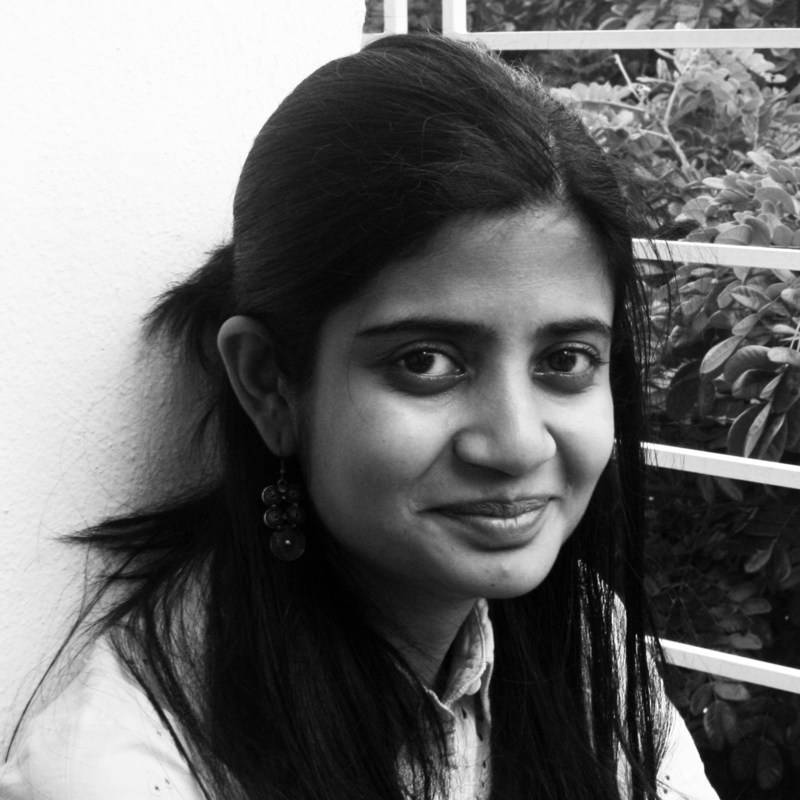
Pooja Saxena makes and works with typefaces, especially those in Indian scripts. See her work here, or follow her on Instagram.
My interest in designing typefaces in Indian scripts grew out of years of disappointment with the way most Hindi books I came across looked. Apart from a few exceptions, they looked like poor cousins of English books. Whether it was a children’s story book or a novel or magazine, there was usually the same drab typeface. Some letters didn’t look like what we were taught in school, on others the matras (vowel marks) didn’t arch at the right places. Overall, the books and the letters inside them had an air of neglect. They looked old and completely unexciting. When I first learned that designing typefaces was a real job, I thought here was the opportunity to change all that.
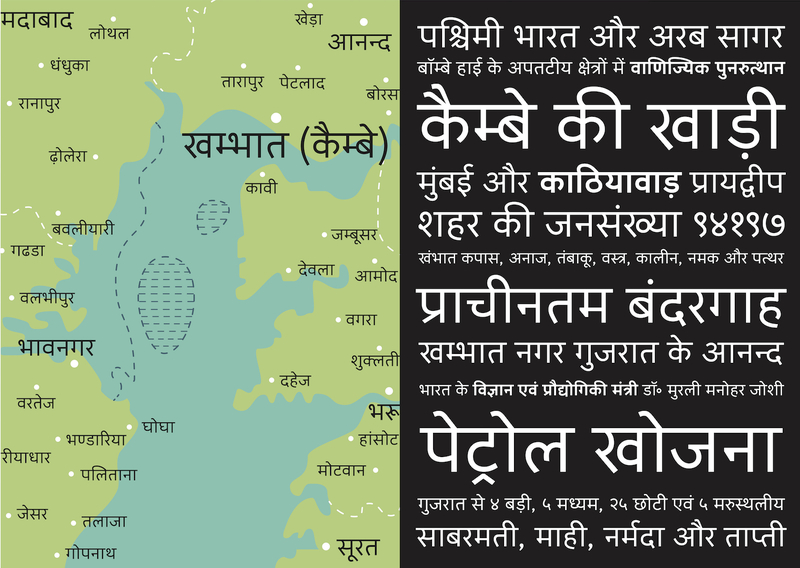
Cambay, Devanagari typeface designed by Pooja Saxena for Google Fonts
Changing the typographic landscape of a country as diverse as India is not a one-woman job, but every now and then a project comes by that has the potential to make a small difference. Two years ago, as a result of a conversation with Subhashish Panigrahi, the Access to Knowledge programme at the Centre for Internet and Society commissioned a Ol Chiki typeface family. The Ol Chiki script, about which I knew precious little at the time, is used to write the language Santali, which is spoken by over six million people in India and its neighbouring countries. At the time that we started working on this project, there was no Unicode compliant typeface available in the script, making it impossible for it to be used on computers and cellphones, and online in a consistent and future-proof way. We hoped to change that by designing a small, but useful typeface family (it comes in regular, bold and italics) along with input methods and keyboard layouts that would allow a person to type Ol Chiki text easily.
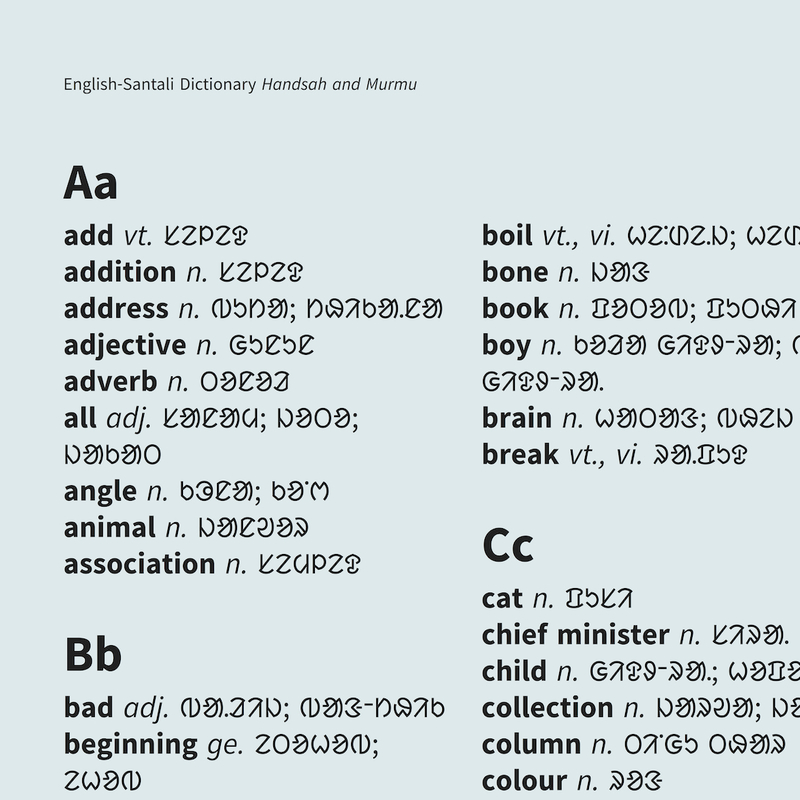
Guru Gomke, Ol Chiki typeface designed by Pooja Saxena with research inputs from Shubhashish Panigrahi,
for the A2K Programme at the Centre for Internet and Society.
This project was especially challenging because not only was Ol Chiki a completely unfamiliar script to me and Subhashish, but there was limited material available for us to consult. While designing a typeface in a script one reads and/or writes, or is at least familiar with, one’s experience with those letters can act as a guide. By writing them and seeing them printed in different fonts, in many people’s handwriting — some good, some bad — and on hand painted signs, one develops an instinct for identifying which parts of a letter make it recognisable. That way we know what parts of the letter can be exaggerated, and what others can be played down without compromising legibility. For an unfamiliar script, this visual vocabulary and the traditionally correct way of writing letters must be learned. Manuscripts, printed documents, handwriting manuals and samples, metal type, linguistic information about the script, feedback from native readers — all form parts of a puzzle that needs to be put together to design a competent typeface.
The story of Ol Chiki script is fascinating. The script is less than a century old, and was devised by Pandit Raghunath Murmu, who wanted to create a script that could accommodate all the features of the Santali language — something that the scripts used to write Santali so far had failed to do. Legend has it that he based the design of the letters on objects commonly found in the everyday environment of the Santals. Even though the script was created between 1920 – 1940, the Santal community has many myths about how it was created. One says that the script came to be at the time when the Earth itself was created, another says that the script was given as a divine gift to a learned man, Pandit Raghunath Murmu. It is after Pandit Raghunath Murmu, who is reverentially called Guru Gomke, that the Ol Chiki typeface that I designed was named. You can find out more about the Ol Chiki typeface and input methods project here.
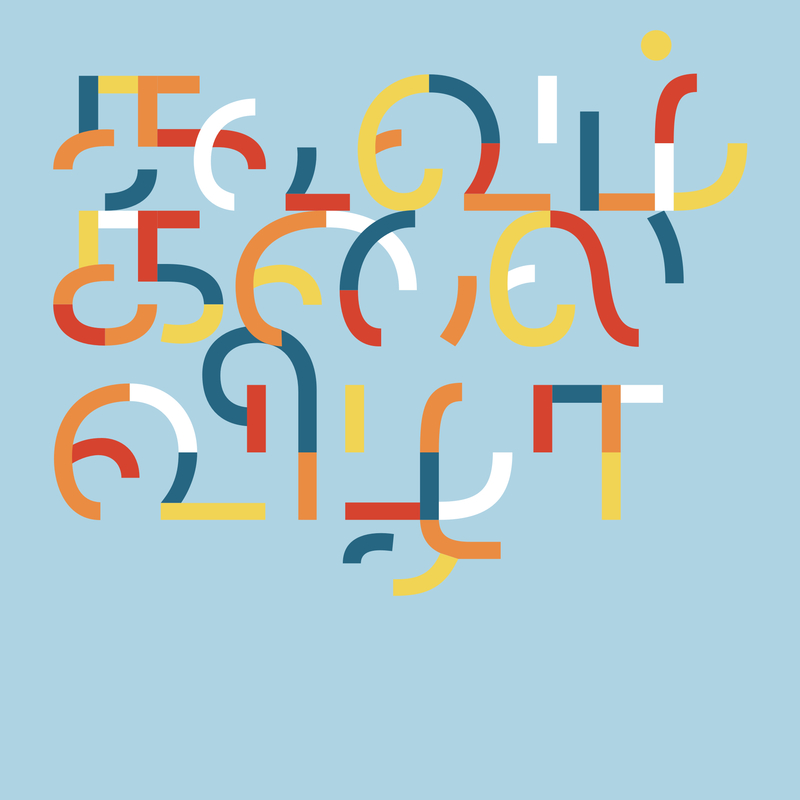
Custom lettering for the Tamil branding of the Coovum Art Festival, designed by Pooja Saxena
If you’re interested in Indian type design and le ering, consider following the work of these exceptional designers — Noopur Datye, one of the co-founders of type design collective, Ek Type, who has designed custom typefaces TV channels like LifeOK; Kimya Gandhi, who is partner at Mota Italic, and recently designed an inventive Devanagari handwriting font; or Lipi Raval, whose flamboyant Gujarati typeface Mogra is a complete head-turner.
Be the first to comment.
Hackathons Usher in New Chapter for Children’s Books in Cambodia
Posted by Remya Padmadas on December 13, 2016by Elita Ouk. Photographs by Wendy Rockett.
Elita is a consultant for The Asia Foundation in Cambodia and Wendy Rockett is the Foundation’s Books for Asia senior communications manager. The views and opinions expressed here are those of the author and not those of The Asia Foundation or its funders. This post was originally published in The Asia Foundation’s In Asia blog here.
On September 18, nearly 20 publishers, editors, writers, and young technologists, ready with pencils and laptops, filled a co-working space in Cambodia’s capital, Phnom Penh, for the country’s first children’s e-book hackathon. The hackathon is part of Let’s Read! an Asia Foundation initiative that applies technology interventions to stimulate reading in developing Asian countries. By the end of the day, participants had created a series of engaging, original children’s content in electronic format, all in the Khmer language.
According to a 2015 Asia Foundation research study, 40 percent of Cambodian phone users own at least one smartphone, and a third of the population has access to the internet. Such increased access to technology is also opening up new opportunities for educational material to reach parents, teachers, and children, and helping to formulate a new way of publishing children’s content.
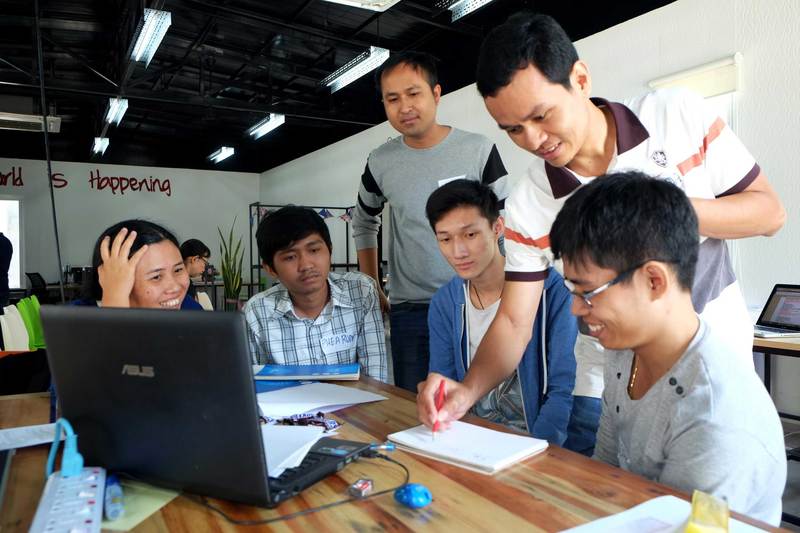
Hackathons have the potential to invigorate children’s book creation and distribution in Cambodia, where small amounts of children’s reading material are published every year. Shifting publishing from a linear process to a collaborative model lowers development and production costs and dramatically compresses the turnaround time. Photos by Wendy Rockett
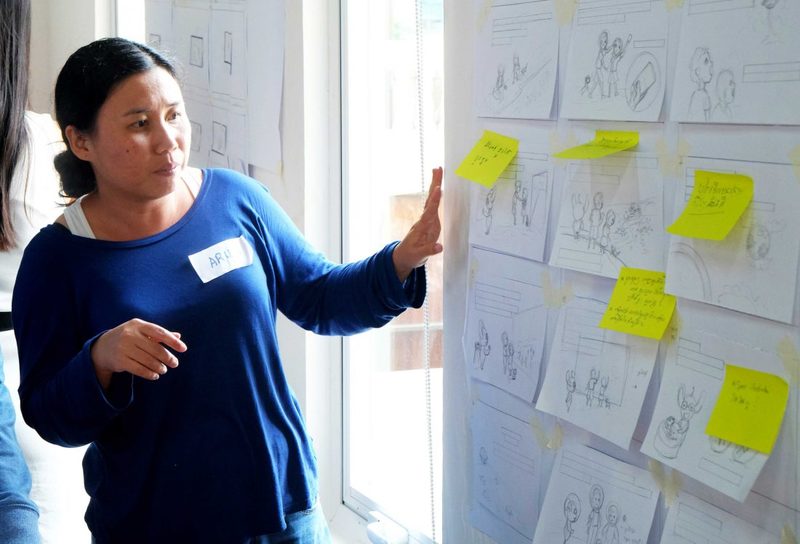
Hackathon participants were divided into teams, each with a writer, illustrator, designer, and coder. An editor and children’s book experts from Room to Read guided the teams through the process, from conception to detailed storyboards and finished covers.
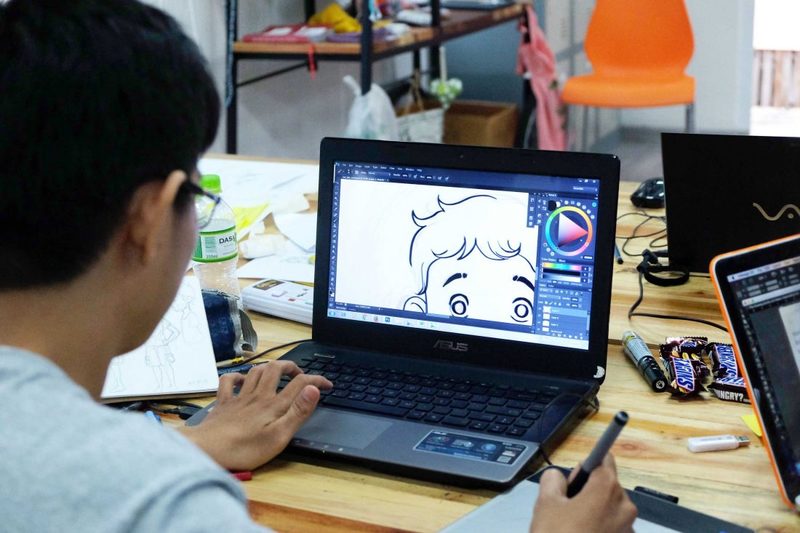
The teams spent most of the day refining the stories, with writers working closely with the editor to strengthen the narrative and sharpen the language, while illustrators continually refined storyboard drawings and cover art to make sure they were compelling to children.

For most of the writers and illustrators, the hackathon was the first time they had ever worked directly with each other in real time.
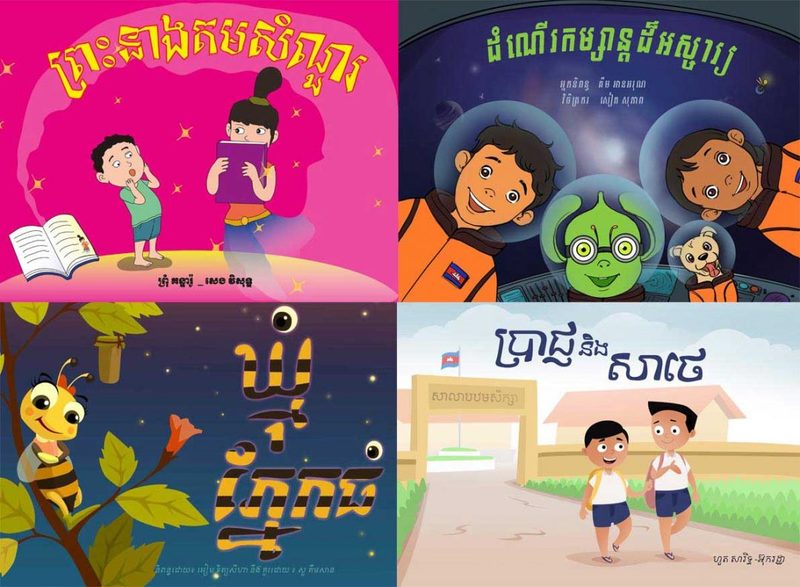
In 11 action-packed hours, the teams produced four stories that were further refined after the event: Big-Eyed Bee, the story of an adventurous and clever bee; Prach and Sathae, a tale of two boys who learn to resolve their differences; The Amazing Journey, the travels of a boy and girl with an intrepid alien; and The Storybook Princess, which captures the magic of storytime.

The Let’s Read! books will be freely available from the Ministry of Education’s Open Education Resource site, as well as through digital library apps such as Khmer LEARN for anyone to download, read, and adapt for their own use. The books will also be offered in e-pub and print-ready formats.
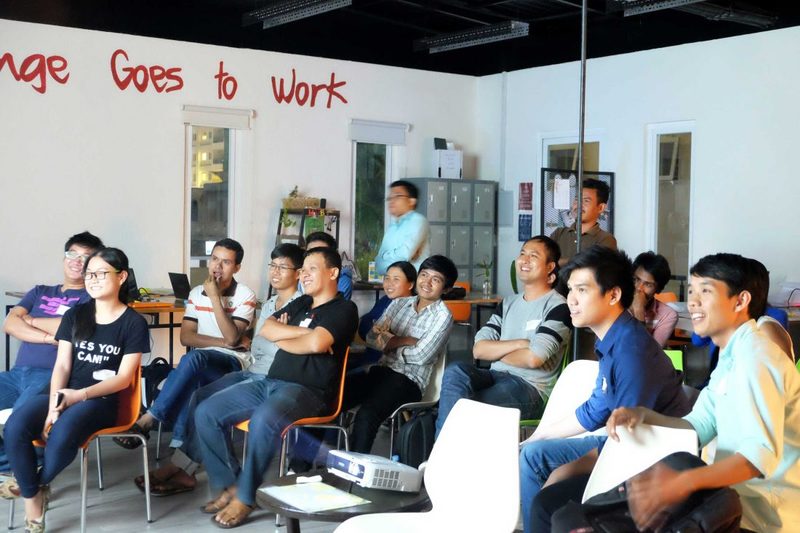
With the support of Smart Axiata, one of Cambodia’s leading telecom companies, the next hackathon in March 2017 will incubate even more publishing talent and further expand the quality and diversity of local children’s books.
Read more about Let’s Read!
You can follow The Asia Foundation on Twitter and Facebook.
Be the first to comment.